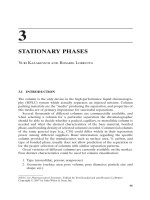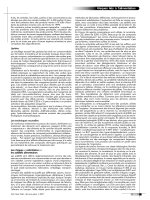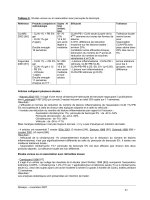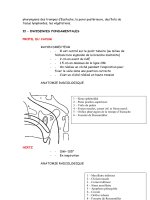Pals pediatric advanced life support review - part 3 doc
Bạn đang xem bản rút gọn của tài liệu. Xem và tải ngay bản đầy đủ của tài liệu tại đây (124.83 KB, 17 trang )
CHAPTER 2 Recognition of Shock and Respiratory Failure 17
❍
Describe the signs you expect to see in cardiopulmonary failure.
A child in cardiopulmonary failure presents with global deficits in oxygenation, ventilation, and perfusion. This
patient may be cyanotic, bradycardic, and severely hypoperfused. This very ominous constellation of clinical signs
immediately precedes a complete cardiopulmonary arrest.
❍
What should you do for this patient?
A child who presents in cardiopulmonary failure requires the immediate establishment of a patent airway, initiation
of assisted ventilation, administration of l00% oxygen, and vascular access for fluid resuscitation and medications.
❍
What are the causes of respiratory failure in a child who has suffered trauma?
Respiratory failure may occur as a result of an injury to the brain, upper airway obstruction following trauma,
injury to the lung or chest wall, or even intra-abdominal injury with restriction of movement of the diaphragm.
❍
What traumatic chest injuries may result in respiratory failure?
Pneumothorax, hemothorax, pulmonary contusion, and flail chest.
❍
What are the major causes of hemorrhagic shock?
Trauma injuries to solid organs (liver or splenic laceration, hemothorax), fractures of large bones (femur fracture,
pelvic fracture), and intracranial injury with hemorrhage or large soft tissue lacerations (scalp laceration) are all
sources of significant blood loss.
❍
What are some of the complications associated with burns in young children?
Significant fluid loss through the burn and extravascular tissue occurs in children with burns in excess of l0% of the
total body surface area. Inhalation injury from toxins and thermal injury may cause upper airway obstruction or
respiratory failure and carbon monoxide poisoning.
❍
What is epiglottitis?
Epiglottitis is an invasive bacterial disease causing inflammation and edema of the epiglottis and a common cause of
severe upper airway obstruction in children. Now it is more common in adults.
❍
What are the causes of acute deterioration during positive pressure ventilation?
Endotracheal tube obstruction (mucus, blood, secretions), displacement (into the esophagus, pharynx, or right
main stem bronchus), tension pneumothorax, and mechanical equipment failure. These causes may be remembered
by the DOPE mnemonic:
D—dislodgement
O—obstruction
P—pneumothorax
E—equipment failure
❍
How does respiratory distress or failure develop during seizures?
Poor chest wall movement occurs during generalized tonic seizures leading to hypoventilation. Upper airway
obstruction may be caused by tongue displacement and secretions. The effect of the above factors can be
18 PALS (Pediatric Advanced Life Support) Review
compounded by medications that cause respiratory depression. It is important to continuously monitor a child
(especially heart rate and oxygen saturation) during and following seizures.
❍
What are the causes that predispose a child to stroke?
Prematurity, sickle cell anemia, cyanotic congenital heart disease, coagulation disorders, trauma, and arterial venous
malformation.
❍
What data exist about the use of TPA for the treatment of stroke in neonates, infants and children?
There is little data regarding the use of TPA for the treatment of strokes in patients less than l8 years of age.
However, thrombolytic drugs may have some role in very select and unusual pediatric clinical entities.
❍
What are the signs of increased intracranial pressure?
Altered mental status (combativeness, irritability, somnolence), abnormal pupils (pupillary dilatation, lack of
response to light, unequal size), and abnormal motor posturing.
❍
What are the indications for intubation of a comatose child?
Depressed mental status can be associated with hypoventilation (and the development of hypoxia and hypercarbia),
loss of protective air reflexes, and increased intracranial pressure. Intubation is indicated for oxygenation, control of
intracranial hypertension (through mild hyperventilation), and protection of the airway.
❍
What is Cushing’s triad?
Cushing’s triad is the combination of bradycardia, hypertension, and irregular ineffective respiration. It is a late sign
of increased intracranial pressure and impending herniation.
CHAPTER 3
Pediatric Basic Life
Support
“If you want to see what children can do, you must stop giving
them things.” —Norman Douglas
❍
T/F: Injury prevention is an important part of a community-wide effort to improve life support for infants
and children.
True.
❍
Who is usually present when a child has an out-of-hospital arrest?
Parents or surrogates.
❍
Other than to parents, to whom should BLS courses be offered?
Day care personnel, teachers, and coaches.
❍
T/F: Chronic illness is a risk factor for cardiopulmonary failure in children.
True.
❍
What should the content of BLS courses include?
Prevention, BLS techniques, and EMS system access.
❍
What group of professionals could take PALS courses?
All prehospital and hospital personnel who care for infants and children.
❍
T/F: Primary cardiac arrest is the most common cause of death in young children.
False. It is uncommon in children. Respiratory arrest usually precedes cardiac arrest.
❍
What percent of children present with ventricular fibrillation as a cause of pulseless arrest outside of the
hospital?
10–15%. Most are in asystole.
19
Copyright © 2007, 2006 by The McGraw-Hill Companies, Inc. Click here for terms of use.
20 PALS (Pediatric Advanced Life Support) Review
❍
Ventricular fibrillation is more likely in which patients?
Children >10, submersion victims, and those with congenital heart disease and in-hospital arrest.
❍
What is the common primary cause of pulseless cardiac arrest?
Injury or disease leading to respiratory or circulatory failure.
❍
What percent of children survive pulseless out of hospital arrest?
Survival is uncommon, about 10%.
❍
In children, prehospital resuscitation should include what three things?
Effective ventilation, oxygenation, and the prevention of cardiac arrest.
❍
Cardiopulmonary arrest occurs predominately in which two pediatric age groups?
Infants <1 year and adolescents.
❍
What are some of the common causes of cardiac arrest in infants?
SIDS, injury (unintentional and intentional), ALTE, respirator y disease, airway obstruction, submersion, sepsis,
and neurologic disease.
❍
What is the most common cause of death in children >1 year of age?
Injury.
❍
What three principles of injury prevention should be emphasized?
Passive injury prevention strategies
Specific instructions rather than general advice
Individual instruction reinforced by community-wide educational programs
❍
Name the six most common types of severe childhood injuries.
Motor vehicle passenger injuries
Pedestrian or bicycle injuries
Child maltreatment (abuse)
Submersion
Burns
Firearm injuries
❍
Motor vehicle trauma accounts for what percent of all pediatric injuries and deaths?
Almost 50%.
❍
What is the most important device to prevent pediatric motor vehicle injuries and deaths?
A properly installed child restraint device.
CHAPTER 3 Pediatric Basic Life Support 21
❍
Do driver education classes reduce the incidence of collisions involving adolescents?
No, these classes have increased the number of drivers without improving safety.
❍
What percent of adolescent motor vehicle fatalities involve alcohol?
50%.
❍
What roadway improvements could help decrease pedestrian injuries?
Adequate lighting, sidewalk construction, and roadway barriers.
❍
What type of injury causes most bicycle related morbidity and mor tality?
Head injury.
❍
What percent of head injuries could bike helmets eliminate?
85% of head injuries and 88% of brain injuries.
❍
What three things must helmet programs ensure to be successful?
Acceptability, affordability, and accessibility of helmets.
❍
What type of fence should enclose private swimming pools?
5-feet high with self-latching and self-closing gate.
❍
What percent of fire-related deaths result from house fires?
80%.
❍
What types of burns are common in children of 4 years and younger?
Smoke inhalation, scalds, and electric burns.
❍
Smoke detectors can reduce the risk of death and severe injury by what percentage?
90%.
❍
How often should smoke detector batteries be changed?
Twice a year.
❍
T/F: Firearms are a leading cause of accidental death and injury in children.
True.
❍
Most guns found in the home used in unintentional shootings share what two characteristics?
They are loaded and are readily accessible.
❍
T/F: The presence of a gun in the home is linked to adolescent suicide.
True.
22 PALS (Pediatric Advanced Life Support) Review
❍
What are the key components of pediatric BLS?
Sequential assessments and motor skills designed to support or restore effective ventilation and circulation.
❍
What is the first step in BLS?
Determine level of consciousness.
❍
Why must unnecessary moving or shaking of the child be avoided?
To prevent potential spinal cord injury.
❍
T/F: An awake child with respiratory distress should be laid on the ground or on a stretcher.
False. Children with partial airway obstruction will find the most comfortable position on their own.
❍
If the child is conscious, when should EMS be activated?
Immediately.
❍
If the child is unconscious, how long should the rescuer provide BLS before activating EMS?
For unresponsive infants and children, the lone rescuer should provide 5 cycles (about 2 minutes) of CPR before
phoning 911 and, for the child, retrieving the AED. Most pediatric arrests are respiratory in origin, so 2 minutes
may be enough to restore ventilation and oxygenation or prevent respiratory arrest from progressing to cardiac
arrest.
❍
In an unconscious child, when should EMS be activated immediately?
When two rescuers are present. The 2005 guidelines also recommend activation and retrieval of an AED (when
available) first, even with a lone rescuer, if the child has a sudden witnessed collapse, as such is likely to be of cardiac
origin.
❍
What should be done if trauma is suspected?
Manual stabilization is preferred to complete immobilization of the spine in the 2005 AHA guidelines as
immobilization devices may interfere with effective CPR.
❍
What are the most important components of BLS?
Establishment and maintenance of a patent airway and support of adequate ventilation.
❍
In an unconscious victim, what causes airway obstruction?
Relaxation of muscles and posterior displacement of the tongue.
❍
How can the airway be opened in an unconscious, apneic victim?
Head tilt–chin lift.
❍
How can the airway be opened in an unconscious, apneic victim if neck trauma is suspected?
Jaw thrust with manual neck stabilization. If this does not open the airway, the health care provider should perform
the head tilt-chin lift maneuver because opening the airway is a priority for the unresponsive trauma victim. The
CHAPTER 3 Pediatric Basic Life Support 23
2005 AHA guidelines recommend that all lay providers be taught to perform head tilt–chin lift only, regardless of
potential spinal injury.
❍
How is the head tilt–chin lift performed?
One hand is used to tilt head and gently extend the neck. The index finger of the opposite hand lifts the chin
outward.
❍
After the airway is established, how does the rescuer assess breathing?
Looks for rise and fall of the chest, listens for exhaled air, and feels for exhaled airflow at the mouth.
❍
What is the recovery position used for?
When the victim is unconscious but has no evidence of trauma and is breathing effectively. The position may
support the head and neck and so should also be used when you must leave the victim with a suspected spinal injury.
❍
How is the victim moved into the recovery position?
The head, torso, and shoulders are moved simultaneously so that the victim is on his or her side.
❍
T/F: Rescue breathing is provided for all victims.
False. Only those victims who have no spontaneous breathing.
❍
In infants, how should rescue breaths be provided?
By placing your mouth over the victim’s nose and mouth.
❍
How many breaths are supplied in rescue breathing?
Two slow breaths, 1 second each, separated by a pause to take a breath.
❍
What is the purpose of the pause between rescue breaths?
To maximize oxygen content.
❍
T/F: Rescue breaths are the most important form of support for the nonbreathing child.
True.
❍
How does the rescuer know if ventilation is not effective?
The child’s chest does not rise.
❍
Why should breaths be delivered slowly?
To minimize the pressure required for ventilation and to prevent gastric distension.
❍
What is the most common cause of air way obstruction?
Improper opening of the airway.
24 PALS (Pediatric Advanced Life Support) Review
❍
What should the rescuer do if ventilation is unsuccessful?
Reposition the head in the midline, place a towel under the shoulders, and consider progressively extending the
neck, provided trauma is not suspected.
❍
How may a second rescuer prevent gastric distension?
By providing cricoid pressure.
❍
What happens when cricoid pressure is performed?
The trachea is displaced posteriorly compressing the esophagus against the vertebral column.
❍
In a patient with a tracheostomy, how is air leakage prevented during rescue breathing?
The victim’s mouth and nose are sealed by the rescuer’s hand or a tight fitting mask.
❍
Are barrier devices effective for mouth-to-mouth ventilation?
There are no adequate studies of the effectiveness of barrier devices.
❍
When should the rescuer determine the need for chest compressions?
After the airway is opened and two rescue breaths provided.
❍
T/F: If the child is not breathing, chest compressions are usually required.
True. Heart rate and stroke volume are probably not adequate if the child is not breathing.
❍
What complications are common in children who receive CPR?
None. Rib fractures in children are usually attributable to preceding trauma.
❍
How long should the layperson spend looking for a pulse in a nonbreathing child?
No time. Laypersons often have difficulty recognizing pulses and should begin chest compressions immediately if
the patient is not breathing or moving.
❍
Where should the pulse be checked by health care professionals in infants?
Brachial artery.
❍
Where should the pulse be checked by health care professionals in children?
The carotid artery should be used in children greater than 1 year of age.
❍
If a pulse is present, how often should breaths be given?
At a rate of 12–20 per minute (one breath every 3–5 seconds).
❍
If a pulse is present, when should EMS be activated?
After 20 breaths or 1 minute.
CHAPTER 3 Pediatric Basic Life Support 25
❍
What is the purpose of chest compressions?
To circulate oxygen-containing blood to the vital organs.
❍
What are the two theories for the mechanism of blood flow during chest compressions?
Thoracic pump theory and cardiac pump theory.
❍
To achieve optimal compressions, how should the child be positioned?
Supine on a hard, flat surface.
❍
Where should you perform chest compressions on infants?
Lower half of the sternum.
❍
How far should the infant’s sternum be depressed during compressions?
1/3–1/2 the depth of the chest.
❍
What should the rate of compressions be during infant CPR?
At least 100 times per minute.
❍
What should the compression to ventilation ratio be?
30:2 when provided by laypersons or a lone health care provider and 15:2 when performed by two health care
providers.
❍
After what period of time should EMS be activated?
Five cycles of CPR, about 2 minutes. For sudden, witnessed collapse, activate after verifying that victim is
unresponsive.
❍
Children fall into what age-range for the purposes of BLS?
Ages 1–8 years.
❍
T/F: Compressions in children should be performed with the fingers.
False. Compressions should be performed with the heel of the hand.
❍
What should the compression rate in children be?
100 times per minute.
❍
What should the compression to ventilation ratio in children be?
30:2 for laypersons and lone health care providers. 15:2 when performed by two health care providers.
❍
How often should the infant and child be reassessed?
The lay rescuer is taught to continue CPR at a rate of 30:2 compressions: ventilations until an AED arrives, the
victim begins to move, or professional responders take over and not to stop for reassessments. Health care providers
may reassess after 5 cycles of CPR, about 2 minutes.
26 PALS (Pediatric Advanced Life Support) Review
❍
How is air way patency maintained during compressions?
The hand not doing compressions is used to maintain the head tilt.
❍
What information should be given to EMS?
Location of the emergency
The telephone number from which the rescuer is calling
What happened
Number of victims
Nature of resuscitation
❍
T/F: The majority of deaths from foreign body aspiration occur in children less than 5 years of age.
True.
❍
List the common objects that can be aspirated.
Toys, balloons, hot dogs, candies, nuts, and grapes.
❍
What is a hallmark of foreign body aspiration?
Sudden onset of respiratory distress.
❍
When should infectious causes of airway obstruction be considered?
When the child has fever.
❍
Name two infectious causes of airway obstruction.
Croup and epiglottitis.
❍
When should attempts to clear the airway be considered?
When foreign body aspiration is witnessed or strongly suspected and when the airway remains obstructed during
rescue breathing attempts.
❍
T/F: Relief of airway obstruction should be attempted for all patients with foreign body aspiration.
False. Only if signs of complete obstruction are observed.
❍
What are the signs of complete airway obstruction?
Ineffective cough, increased respiratory difficulty, development of cyanosis, and loss of consciousness.
❍
How does the Heimlich maneuver relieve foreign body obstruction?
It increases intrathoracic pressure, creating an artificial cough, which forces air and foreign bodies out of the airway.
❍
For infants, what is the method by which complete foreign body obstruction is relieved?
A combination of back blows and chest thrusts.
CHAPTER 3 Pediatric Basic Life Support 27
❍
Why should the Heimlich maneuver not be performed on infants?
There is a potential for liver injuries in these patients.
❍
Why should blind finger sweeps be avoided?
The foreign body may be pushed back into the airway.
❍
How should back blows be delivered in an infant?
Hold the infant face down, resting on forearm. The head should be lower than the trunk. Deliver back blows
between scapulae with heel of hand.
❍
How many back blows should be given?
Five.
❍
T/F: Chest thrusts in a choking infant are delivered in the same manner as chest compressions.
True.
❍
How long should the rescuer continue the series of back blows and chest thrusts?
Until the object is expelled or the infant becomes unresponsive.
❍
How are foreign bodies expelled in the conscious child?
Abdominal thrusts while standing behind victim.
❍
What should the protocol include if the child becomes unconscious?
Attempt to visualize foreign body and remove it (the 2005 AHA guidelines no longer teach the tongue-jaw lift)
Attempt rescue breathing
Straddle victim and perform abdominal thrusts
Repeat above steps until ventilation is successful
❍
In the pediatric trauma victim, what may cause airway obstruction?
Soft tissue swelling, blood, vomitus, or dental fragments.
❍
What method should be used to open the airway in the trauma victim?
Jaw-thrust ensuring that spinal stabilization has been achieved.
❍
Why is it difficult to maintain neutral c-spine position in infants and young children?
Prominent occiput predisposes the neck to slight flexion when the child is placed on a flat surface; this is why it is
recommended to place a small towel under the shoulders to maintain the neck in neutral position.
This page intentionally left blank
CHAPTER 4
Airway and Ventilation
“I have found the best way to give advice to your children is to
find out what they want and then advise them to do it.”
—Harry S Truman
Respiratory problems are common in infants and children and are an important cause of in- and out-of-hospital cardiopul-
monary arrest in the pediatric age group. Assessment and treatment decisions must be made quickly to prevent progression
and deterioration to respiratory failure and cardiopulmonary arrest. If respiratory failure or respiratory arrest is promptly
treated, intact survival of the child is likely. However, once respiratory arrest progresses to pulseless cardiac arrest, outcome is
poor. Therefore, early recognition and effective management of respiratory problems are fundamental to pediatric advanced
life support.
This chapter reviews the techniques and adjuncts used in airway management and the priorities of assessment and
treatment of the infant and child with respiratory insufficiency or failure. Timely and appropriate use of these techniques
and adjuncts is critical to the survival of the patient.
❍
Why should respiratory failure be treated promptly?
To avoid progression to cardiac arrest, which has a poor outcome in children.
❍
List the six ways the pediatric airway differs from the adult airway.
The airway is smaller
The tongue is relatively larger
The larynx is more cephalad in position
The epiglottis is short, narrow, and angled away from the trachea
The vocal cords attach lower anteriorly
In children less than 10 years of age, the narrowest portion of the airway is subglottic
❍
How can small amounts of edema effect the pediatric airway?
They can significantly reduce airway diameter in children.
❍
Why should a straight laryngoscope blade be used in children?
The high position of the larynx makes the angle between the tongue and glottis more acute.
❍
Should endotracheal tube size be based on the size of the glottic opening or the size of the cricoid ring?
The cricoid ring, as this is the narrowest part of the trachea in children.
29
Copyright © 2007, 2006 by The McGraw-Hill Companies, Inc. Click here for terms of use.
30 PALS (Pediatric Advanced Life Support) Review
❍
How is airflow resistance related to airway radius?
Inversely propor tional to the fourth power of the airway radius during laminar flow (quiet breathing), and inversely
proportional to the fifth power of airway radius during turbulent airflow.
❍
Why should the child with airway obstruction be kept calm?
To prevent the generation of turbulent airflow.
❍
What structures normally support the lungs?
The ribs and sternum.
❍
Why do the ribs fail to support the lungs adequately in the child?
They are ver y compliant.
❍
What happens to functional residual capacity when respiratory effor t is diminished?
It is reduced.
❍
What is paradoxical chest movement?
Sternal and intercostal retractions in response to airway obstruction during active inspiration.
❍
On what does tidal volume in infants and toddlers depend?
Movement of the diaphragm.
❍
Why is the pediatric airway susceptible to dynamic collapse during airway obstruction?
High compliance of the airway.
❍
How does PEEP improve airway exchange?
By opposing the forces that cause dynamic airway collapse.
❍
Why do children have a high oxygen demand per kilogram?
Their metabolic rate is high.
❍
Does hypoxemia occur more quickly in the child or adult in response to apnea?
The child, secondary to high oxygen consumption.
❍
How does hypoxemia occur in response to respiratory distress?
The disease process decreases lung compliance
The disease process increases airway resistance
The disease process interferes with oxygen or carbon dioxide exchange
Ventilation perfusion mismatch
CHAPTER 4 Airway and Ventilation 31
❍
What are the two primary goals of emergency airway management?
To anticipate and recognize respiratory problems
To support or replace functions that are reduced or lost
❍
Why should oxygen be administered to all seriously ill or injured patients?
Oxygen delivery to tissues may be limited because of the arrest circulatory state.
❍
Why should oxygen be humidified?
To prevent obstruction of small airways by dried secretions.
❍
Why should a heated humidification system be used?
To prevent hypothermia in small patients.
❍
Why should children in respiratory distress be allowed to maintain a position of comfort?
This position usually allows the maximal airway patency and minimizes respirator y effort.
❍
What does anxiety do to oxygen consumption?
Increases it.
❍
What are the alternative methods of providing oxygen supplementation?
Blow-by or oxygen tent.
❍
What causes airway obstruction in a somnolent or unconscious child?
Neck flexion, relaxation of the jaw, posterior displacement of the tongue, and collapse of the hypopharynx.
❍
What can occur if breaths with a bag-valve-mask are not coordinated with the child’s breathing
efforts?
Coughing, vomiting, laryngospasm, and gastric distension.
❍
Why is pulse oximetry an important technique for monitoring respiratory insufficiency?
It provides continuous evaluation of arterial oxygen saturation.
❍
T/F: Pulse oximeters reflect the effectiveness of ventilation.
False, they only evaluate level of oxygenation.
❍
When is the pulse oximeter’s accuracy limited?
In the presence of methemoglobinemia, carbon monoxide poisoning, or in shock states.
❍
Why is the pulse oximeter not useful during shock or poor per fusion?
It requires pulsatile blood flow to determine oxygen saturation.
32 PALS (Pediatric Advanced Life Support) Review
❍
Where may the oximeter probe be placed if a signal is not detected at the fingertip?
Ear lobe, nares, cheek, tongue, and foot.
❍
What is an end tidal CO
2
detector used for?
Allows for confirmation of endotracheal tube placement by percent of CO
2
found in exhaled air.
❍
What is the most accurate method of determining arterial oxygen concentration?
Arterial blood gas.
❍
Why is a low flow oxygen delivery system insufficient to meet all inspiratory flow requirements?
Because with low flow systems, room air is entrained and mixed with the oxygen decreasing the concentration of
oxygen to be inhaled by the patient.
❍
How is delivered oxygen concentration determined?
By the patient’s minute ventilation and gas flow delivery rate.
❍
Which delivery system should be used in an emergency situation, high or low flow?
High flow.
❍
In a simple oxygen mask, what three things can reduce delivered oxygen concentration?
If the patient’s inspiratory flow rate is high, the mask is loose, or the oxygen flow into the mask is low.
❍
What two valves does the nonrebreathing mask include to maximize inspired oxygen concentration?
A valve that prevents entrainment of room air during inhalation
A valve that prevents flow of exhaled gas into the reservoir bag
❍
What is the maximum inspired oxygen concentration achieved with a nonrebreather mask?
95%.
❍
What is an advantage of a face shield?
Permits access to the face without interrupting oxygen flow.
❍
What inspired oxygen concentration can be achieved with an oxygen hood?
80–95%.
❍
Is the nasal cannula a high flow or low flow system?
Low flow.
❍
What is the inspired oxygen concentration delivered by a nasal cannula?
Cannot be easily or reliably determined, but is less than 50%.
CHAPTER 4 Airway and Ventilation 33
❍
What is the indication for use of an oral airway?
In an unconscious child with airway obstruction after usual airway maneuvers have failed.
❍
Why should an oral airway not be used in a conscious child?
May stimulate gagging or vomiting.
❍
How is the appropriately sized oral airway chosen?
Measure from the level of the central incisors, the bite block segment is parallel to the hard palate, and the curved
portion should reach the angle of the jaw.
❍
What is the appropriate length for a nasal airway?
Distance from the tip of the nose to the tragus of the ear.
❍
What suction force is necessar y to suction the airway of an infant or child?
80–120 mm Hg.
❍
What type of suction catheter should be used to suction secretions from an endotracheal tube?
Flexible plastic suction catheter.
❍
Why should the heart rate be monitored during suctioning?
Vagal stimulation and bradycardia can occur.
❍
What is the appropriate therapy once respiratory failure is recognized?
Assisted ventilation.
❍
Why should the space under the mask used for ventilation be small?
To decrease dead space and minimize rebreathing of exhaled gases.
❍
From where to where should the appropriately sized ventilation mask extend?
The bridge of the nose to the cleft of the chin.
❍
When performing bag-valve-mask ventilation, why should pressure on the submental area be avoided?
Can cause the tongue to be pushed into the posterior pharynx leading to obstruction or airway compression can
occur.
❍
Where should the fingers be placed during BVM ventilation?
On the jaw.
❍
What patient position is appropriate during BVM of infants and toddlers?
Supine and head and neck in the neutral sniffing position.









